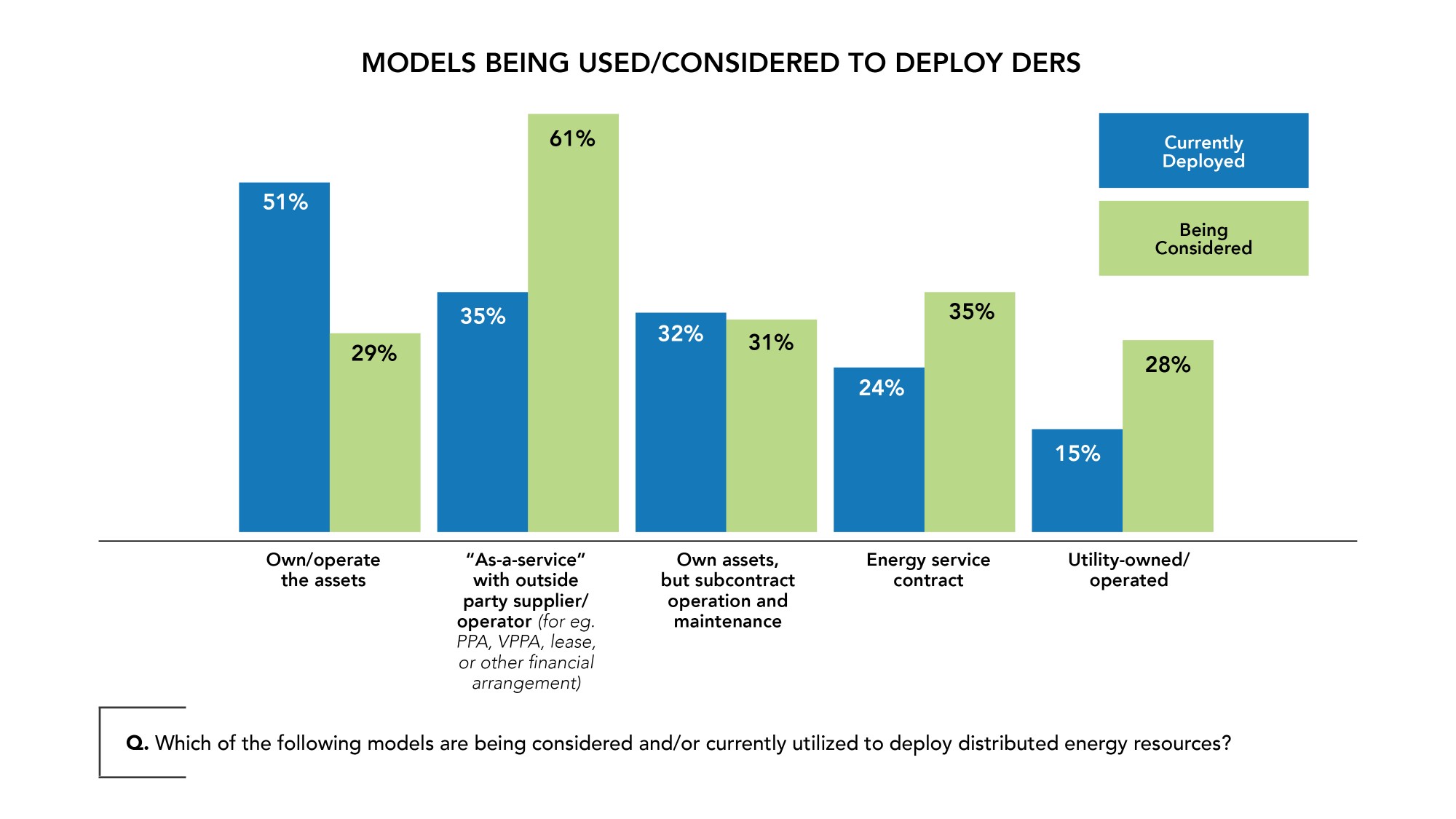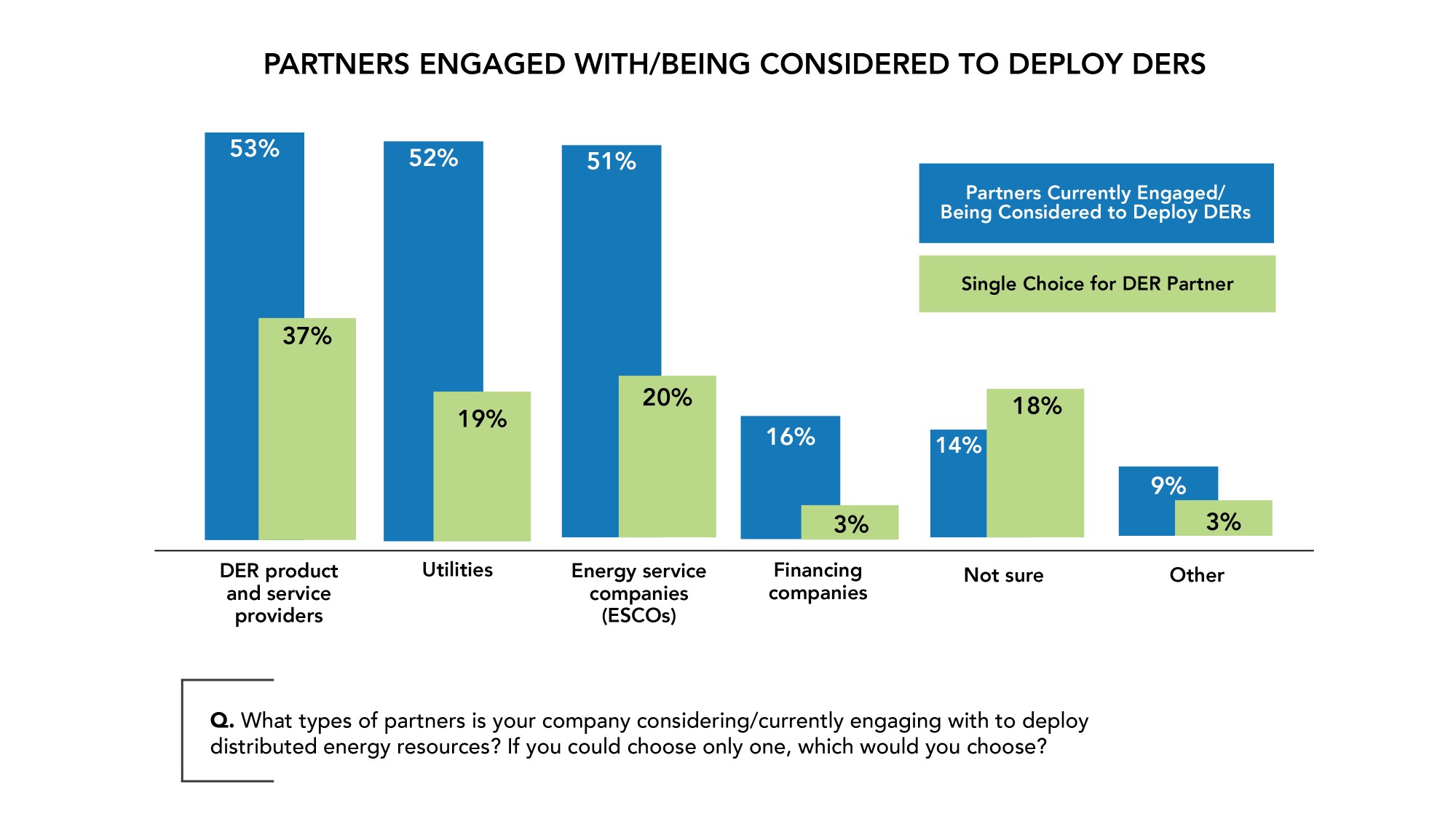Organizations have a myriad of reasons for considering and deploying distributed energy resources (DERs), including cost savings, improved energy efficiency and to help meet emission reduction goals. In order to make the most of the opportunities afforded by DERs, it is important to join with a seasoned energy partner who can help to evaluate your operations as a whole, explain potential complexities, and recommend the best DER fit and strategy for your business.
New financial arrangements for DER partnerships are more prevalent than ever and helping businesses keep pace with the modernizing energy ecology. In the 2020 “State of Distributed Energy Resources Study” conducted by Smart Energy Decisions and sponsored by NRG Energy, we see that after owning/operating the asset themselves (51%), the most common choice of model used to deploy DERs is as-a-service, where outside suppliers act as operators. This template allows companies to reap the benefits of DERs without a large expenditure, which solves the barrier of lack of capital, which was cited by 38% of respondents. The as-a-service model, which includes PPAs, leases, or other financial arrangements, is currently used by 35% of survey respondents. A further 61% are considering the use of as-a-service models, a clear indicator of the appeal of an external entity managing DER assets.

More than half (53%) of the survey respondents also revealed that they currently partner with a DER product and service provider and more than a third (37%) are considering taking this step in the future. This partnership is heavily favored by large commercial companies with 68% preferring this method of cooperation. making them – by a wide margin – the top choice over other potential partners, including utilities and energy service companies (ESCOs).

In partnering with a DER producer and service provider, many adopters find that optimal savings, efficiency, and progress toward sustainability goals can be realized through one supplier, often with no up-front cost. Key is the selection of a full-service company with an innovative approach that provides data-based solutions to aggregate and manage the DER. A recent project for NRG involved an operator of datacenters using creative and diverse product and service solutions to power their operation with clean energy. Working together with NRG, the company bundled products and services to create 100% back-up power on-site. The program included solar, generators, chillers, EV charging, an uninterruptible power supply (UPS), and a long-term PPA wind contract. As a result, the project earned a Power Usage Effectiveness (PUE) rating that was 55% above the industry average.
Other partnerships, such as those with Energy Service Companies (ESCOs) have tended to begin as projects with utilities but are now expanding their role to involve other energy customers. This model helps avoid cost impacts on both supply and utility and is favored by industrial operators. On the flip side, these agreements can be expensive, and some believe ESCOs and financing arrangements do not go far enough with performance guarantees.
Utilities have offered popular partnership models although there has been a decline in interest in these types of arrangements. This is due in part to the availability of newer forms of partnership. Additionally, the interconnection challenge looms large for utilities and DER adopters. Regulations are easing slightly, but unfavorable rate structures and slow adoption of the necessary technologies for cross-connection procedures persist. When utilities and regulators are not onboard, DER adopters find it more difficult to implement successful programs.
Results of the “State of Distributed Energy Resources Study” show customers viewing DERs as a means to gain control over their power decisions. However, an education gap and corporate buy-in remain top challenges. We also learned that customers have little patience for middlemen or aggregators, many of whom still have a siloed approach to energy management. New energy partners should provide tools, including a cost-benefit analysis that will lead to corporate buy-in. Partnerships that incorporate the whole operation – including stakeholder involvement, total footprint, load profiles, outage factors, resiliency, efficiency, ROI, and sustainability goals – can turn what is possible into what is optimal.
The breadth of experience is important. Seek a partner with broad market intelligence that can address the challenges and complexities of DER management. Companies that understand the uniqueness of your power requirements will have the ability to build out a system that integrates with the grid, corrects inefficiencies and shapes a strong, well-defined partnership. Knowledge of wholesale markets, evolving standards, utility operations, interconnect policies and regulations, incentives, rebates, and leveraged financing is essential to a total solutions package.
Explore how NRG Energy operates, optimizes, and deploys coordinated DER solutions.
Read more in the 2020 State of Distributed Energy Resources Study.
 At NRG, we’re bringing the power of energy to people and organizations by putting customers at the center of everything we do. We generate electricity and provide energy solutions and natural gas to millions of customers through our diverse portfolio of retail brands. A Fortune 500 company, operating in the United States and Canada, NRG delivers innovative solutions while advocating for competitive energy markets and customer choice, working towards a sustainable energy future. More information is available at www.nrg.com. Connect with NRG on Facebook, LinkedIn and follow us on Twitter
At NRG, we’re bringing the power of energy to people and organizations by putting customers at the center of everything we do. We generate electricity and provide energy solutions and natural gas to millions of customers through our diverse portfolio of retail brands. A Fortune 500 company, operating in the United States and Canada, NRG delivers innovative solutions while advocating for competitive energy markets and customer choice, working towards a sustainable energy future. More information is available at www.nrg.com. Connect with NRG on Facebook, LinkedIn and follow us on Twitter
@nrgenergy.
NULL




